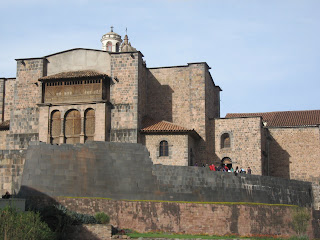
Thursday, October 28, 2010
ChanChan

This site is shown in the Smithsonian Magazine. It is later than the Moche culture and was taken over by the Incas. It was an urban society with irrigation and harvesting of life from the sea. In the extensive ruins only one of many palaces has been restored. It must be protected from the rains of el Niño
Trujillo




Trujillo is a pleasant small city with a proud participation in Peru's independence. In the Plaza de Armas on Sunday, children participate in cultural events. The church tower was right outside our hotel window. The folk dancers are dancing the Marinera. The bed was one Bolivar slept in in a former mansion now a bank.
Pachacamac



Pachacamac has several layers of sites uncovered and work is ongoing. The oldest site has adobe bricks lined up like books in a shelf. The Inca areas include a temple to the sun and an area where women made luxury goods. There is a painted temple and a ceremonial plaza with remnants of posts for sun shades. Agricultural areas come right up to the edges of the site.
Museo de la Nacion

The Museum of the Nation was being remodeled. We saw some Paraca textiles and this balanced historical exposition remembering the period of the Shining Path Terrorists and former president Fujimori's overzealous response. It's sort of like a holocaust museum, meant to remember and learn from the past.
Subscribe to:
Posts (Atom)







































